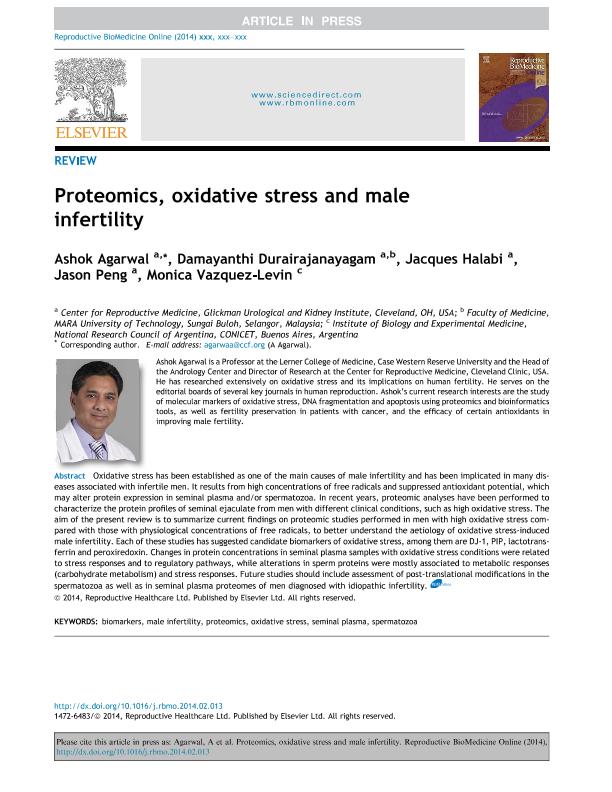Mostrar el registro sencillo del ítem
dc.contributor.author
Agarwal, Ashok
dc.contributor.author
Durairajanayagam, Damayanthi
dc.contributor.author
Halabi, Jacques
dc.contributor.author
Peng, Jason
dc.contributor.author
Vazquez, Monica Hebe

dc.date.available
2016-07-12T16:35:56Z
dc.date.issued
2014-03-12
dc.identifier.citation
Agarwal, Ashok; Durairajanayagam, Damayanthi ; Halabi, Jacques; Peng, Jason; Vazquez, Monica Hebe; Proteomics, oxidative stress and male infertility; Elsevier; Reproductive Biomedicine Online; 29; 1; 12-3-2014; 32-58
dc.identifier.issn
1472-6483
dc.identifier.uri
http://hdl.handle.net/11336/6444
dc.description.abstract
Oxidative stress has been established as one of the main causes of male infertility and has been implicated in many diseases associated with infertile men. It results from high concentrations of free radicals and suppressed antioxidant potential, which may alter protein expression in seminal plasma and/or spermatozoa. In recent years, proteomic analyses have been performed to characterize the protein profiles of seminal ejaculate from men with different clinical conditions, such as high oxidative stress. The aim of the present review is to summarize current findings on proteomic studies performed in men with high oxidative stress compared with those with physiological concentrations of free radicals, to better understand the aetiology of oxidative stress-induced male infertility. Each of these studies has suggested candidate biomarkers of oxidative stress, among them are DJ-1, PIP, lactotransferrin and peroxiredoxin. Changes in protein concentrations in seminal plasma samples with oxidative stress conditions were related to stress responses and to regulatory pathways, while alterations in sperm proteins were mostly associated to metabolic responses (carbohydrate metabolism) and stress responses. Future studies should include assessment of post-translational modifications in the spermatozoa as well as in seminal plasma proteomes of men diagnosed with idiopathic infertility.
dc.format
application/pdf
dc.language.iso
eng
dc.publisher
Elsevier

dc.rights
info:eu-repo/semantics/openAccess
dc.rights.uri
https://creativecommons.org/licenses/by-nc-nd/2.5/ar/
dc.subject
Biomarkers
dc.subject
Male Infertility
dc.subject
Proteomics
dc.subject
Oxidative Stress
dc.subject.classification
Biología Reproductiva

dc.subject.classification
Ciencias Biológicas

dc.subject.classification
CIENCIAS NATURALES Y EXACTAS

dc.title
Proteomics, oxidative stress and male infertility
dc.type
info:eu-repo/semantics/article
dc.type
info:ar-repo/semantics/artículo
dc.type
info:eu-repo/semantics/publishedVersion
dc.date.updated
2016-06-15T19:09:46Z
dc.identifier.eissn
1472-6491
dc.journal.volume
29
dc.journal.number
1
dc.journal.pagination
32-58
dc.journal.pais
Reino Unido

dc.journal.ciudad
Cambridge
dc.description.fil
Fil: Agarwal, Ashok. Center for Reproductive Medicine. Cleveland Clinic. Glickman Urological and Kidney Institute; Estados Unidos
dc.description.fil
Fil: Durairajanayagam, Damayanthi . Center for Reproductive Medicine. Cleveland Clinic. Glickman Urological and Kidney Institute; Estados Unidos. MARA University of Technology. Faculty of Medicine; Malasia
dc.description.fil
Fil: Halabi, Jacques. Center for Reproductive Medicine. Cleveland Clinic. Glickman Urological and Kidney Institute; Estados Unidos
dc.description.fil
Fil: Peng, Jason. Center for Reproductive Medicine. Cleveland Clinic. Glickman Urological and Kidney Institute; Estados Unidos
dc.description.fil
Fil: Vazquez, Monica Hebe. Consejo Nacional de Investigaciones Científicas y Técnicas. Instituto de Biología y Medicina Experimental (i); Argentina
dc.journal.title
Reproductive Biomedicine Online

dc.relation.alternativeid
info:eu-repo/semantics/altIdentifier/url/http://www.rbmojournal.com/article/S1472-6483(14)00130-8/abstract
dc.relation.alternativeid
info:eu-repo/semantics/altIdentifier/doi/10.1016/j.rbmo.2014.02.013
dc.relation.alternativeid
info:eu-repo/semantics/altIdentifier/doi/http://dx.doi.org/10.1016/j.rbmo.2014.02.013
dc.relation.alternativeid
info:eu-repo/semantics/altIdentifier/pmid/24813754
dc.relation.alternativeid
info:eu-repo/semantics/altIdentifier/url/http://www.sciencedirect.com/science/article/pii/S1472648314001308
Archivos asociados
